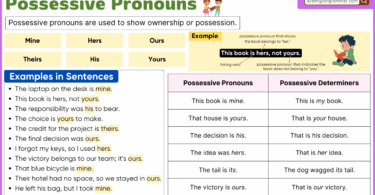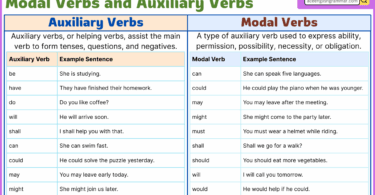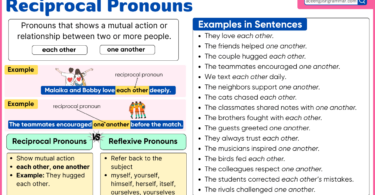Verbs are one of the most important elements in the English language. They are the words that express an action, occurrence, or state of being. There are two basic types of verb in English: regular and irregular. Regular verbs follow a predictable pattern when forming their past tense and past participle forms, while irregular verbs do not follow the same pattern and have their unique forms. In this article, we will focus on irregular verbs and explore their various forms and how to use them correctly in different types of sentences. So let’s get started!
Table of Contents
What Are Irregular Verbs?
Irregular verbs are verbs that do not follow the usual (regular) pattern when forming the past tense (V2) and past participle (V3) forms. Unlike regular verbs that add “-ed” to the base form to create their past and past participle forms, irregular verbs have unique forms that need to be memorized because their forms do not follow the standard rules. Instead, they have unique and often unpredictable changes in their spelling and pronunciation. For example, the verb “go” is irregular. Its past tense form is “went,” which doesn’t follow the expected “-ed” pattern. Similarly, “sing” becomes “sang” in the past tense, and “break” becomes “broke.” These changes are unique to these verbs and are not applied consistently across all irregular verbs.
Example:
- Base Form: Go
- Past Simple: Went
- Past Participle: Gone
Here Instead of adding “ed,” “Go” changes to “went” in the past simple tense and “gone” in the past participle, as in (“I go to school every day, but yesterday, I went to the park. I have gone there many times”).
Learning irregular verbs can be challenging for English learners because there are no fixed rules to predict how they will change. Instead, you must memorize each irregular verb individually, along with its past tense and past participle forms. Over time, as you encounter these verbs in various contexts, you’ll become more familiar with their irregularities and usage.
Regular Verb Vs Irregular Verb
Irregular verb differ from regular verb in how they form their past tense and past participle forms. Regular verbs typically add “-ed” to the base form to create these forms, such as “walk-walked” or “talk-talked.” In contrast, irregular verb undergo unpredictable changes, often altering their spelling or pronunciation entirely. For example, “go” becomes “went,” “sing” changes to “sang,” and “break” becomes “broke.” While regular verbs follow a consistent pattern, irregular verbs require memorization as each has its unique transformation, making them a bit more challenging for English learners. For examples:
Regular Verbs:
- Base Form(V1): Play
- Past Tense(V2): Played
- Past Participle(V3): Played
Irregular Verbs:
- Base Form(V1): Go
- Past Tense(V2): Went
- Past Participle(V3): Gone
Here regular verbs maintain consistency by adding “-ed” to their base form to create past tenses, irregular verbs like “go” exhibit entirely different forms in the past tense (“went”) and past participle (“gone”).
Three Forms of Irregular Verbs
Irregular verbs have three main forms:
- Base Form (V1): This is the infinitive form of the verb and the one typically found in the dictionary. Irregular verb can take various base forms, such as “sing,” “swim,” “go,” or “eat.”
- Past Simple Tense (V2): In the past simple tense, irregular verb can change in various ways from its base form. These changes can include vowel changes, consonant changes, or even completely different forms. Here are some examples:
- Go (base form) à Went (past simple)
- Eat (base form) à Ate (past simple)
- Take (base form) à Took (past simple)
- Past Participle (V3): Irregular verb also have unique past participle forms that is used in perfect tenses (present perfect, past perfect) and passive voice constructions. Past participle forms can be different from both the base form and the past simple form. Examples:
- Go (base form) à Gone (past participle)
- Eat (base form) à Eaten (past participle)
- Take (base form) à Taken (past participle)
Continuous Tenses (V4): They can also be used in continuous tenses (present continuous, past continuous), but the irregularity typically occurs in the base form, not in the continuous tense forms. For example:
- Go (base form) à Going (present continuous)
- Eat (base form) à Eating (present continuous)
- Take (base form) à Taking (present continuous)
Characteristics of Irregular Verbs
Here are some key characteristics of irregular verbs:
No Clear Rule: One of the defining characteristics of irregular verbs is that there is no clear rule or pattern to predict their past tense or past participle forms. Each irregular verb must be memorized individually.
Common Irregular Verbs: There are many irregular verbs in English, and some of the most frequently used ones include:
- be (am, is, are, was, were, been)
- have (had, had)
- go (went, gone)
- do (did, done)
- say (said)
- see (saw, seen)
- come (came, come)
Unpredictable forms: They do not follow a consistent pattern when forming their past tense and past participle. Instead, each irregular verb has its unique form. For example, “go” becomes “went” in the past tense and “gone” in the past participle, while “eat” becomes “ate” in the past tense and “eaten” in the past participle.
Third-Person Singular:
In the present tense, most irregular verbs follow the regular pattern for forming the third-person singular (he/she/it) by adding “-s” or “-es” to the base form. For example, “sing” becomes “sings,” and “swim” becomes “swims.”
Memorization required: Learning irregular verbs requires memorization because there are no consistent rules or patterns to follow. Some of them can be challenging to remember due to their unique forms.
Principal parts: Each irregular verb has three principal parts: the base form (used in the present tense), the past tense form (used in the past simple tense), and the past participle form (used in various tenses, including the present perfect and past perfect). For example, for the irregular verb “sing,” the principal parts are “sing” (base form), “sang” (past tense), and “sung” (past participle).
Inconsistent vowel changes: Irregular verb often involve changes in vowel sounds between the base form and the past tense or past participle forms. These vowel changes can be unpredictable and must be memorized. For example:
- Base form: sing
- Past tense: sang
- Past participle: sung
How to Use Irregular Verbs?
Understanding when and how to use irregular verb is crucial for effective communication. They are used in various tenses, moods, and sentence structures. Let’s explore their usage in different contexts:
Past Actions
Irregular verbs are commonly used to describe actions that occurred in the past. For example:
- Yesterday, I went to the store.
- She ate dinner at 7 PM.
Perfect Tenses
Irregular verbs play a significant role in perfect tenses, such as the present perfect and past perfect. These tenses indicate actions that happened before a certain point in time or actions that have a connection to the present. Examples:
- I have gone to that restaurant before. (Present Perfect)
- She had already eaten when I arrived. (Past Perfect)
Passive Voice
They are also used in passive voice constructions to emphasize the action rather than the doer. For example:
- The book was written by the author.
Continuous Tenses
While the irregularity in these verbs is primarily seen in their base form, they can still be used in continuous tenses to describe ongoing actions. Examples:
- I am going to the park. (Present Continuous)
- They were speaking to the manager. (Past Continuous)
Imperatives and Commands
Irregular verb can be used in imperative sentences and commands. For instance:
- Take a seat and relax.
- Drive carefully on the icy roads.
Irregular Verbs Examples
Irregular verbs in English can be categorized into four basic groups based on how they change in the past tense and past participle forms. Here are the four groups with lists of some common irregular verbs in each group:
Group 1: Verbs that stay the same in the past tense and past participle
| Base Form V1 | Past Tense V2 | Past Participle V3 |
| Put | put | put |
| Let | let | let |
| Cut | cut | cut |
| Burst | burst | burst |
| Hit | hit | hit |
| Hurt | hurt | hurt |
| Read | read | read |
| Set | set | set |
| Spread | spread | spread |
Group 2: Verbs that change their vowel sound in the past tense and past participle
| Base Form V1 | Past Tense V2 | Past Participle V3 |
| Sing | sang | sung |
| Swim | swam | swum |
| Drink | drank | drunk |
| Begin | began | begun |
| Ring | rang | rung |
Group 3: Verbs that change to an entirely different form in the past tense and past participle
| Base Form V1 | Past Tense V2 | Past Participle V3 |
| Go | went | gone |
| Be | was/were | been |
| Have | had | had |
| Do | did | done |
| Say | said | said |
Group 4: Verbs that end in “-en” in the past participle form
| Base Form V1 | Past Tense V2 | Past Participle V3 |
| Break | broke | broken |
| Choose | chose | chosen |
| Speak | spoke | spoken |
| Awaken | awoke | awoken |
| Eat | ate | eaten |
| Freeze | froze | frozen |
| Hide | hid | hidden |
| Write | wrote | written |
| Throw | threw | thrown |
| Take | took | taken |
| Swear | swore | sworn |
| Steal | stole | stolen |
| Rise | rose | risen |
Irregular Verbs Exercises
Here’s an exercise to help you practice irregular verbs. Fill in the blanks with the correct past tense or past participle form of the irregular verb provided in parentheses:
- She __________ (go) to the Lahore yesterday.
- He __________ (see) an amazing movie last weekend.
- I accidentally __________ (break) my phone screen.
- They__________ (go) to the beach last weekend.
- He __________ (eat) a whole pizza for dinner.
- She __________ (take) the bus to work this morning.
- They __________ (speak) to the manager about the issue.
- He ___________ (sing) a beautiful song at the talent show.
- She ___________ (write) a touching letter to her grandmother.
- The caterpillar ___________ (become) a butterfly.
Answers:
- went
- saw
- broke
- went
- ate
- took
- have spoken
- sang
- wrote
- became
FAQs
Q1: What are irregular verbs?
Irregular verbs are a subset of verbs in English that do not follow the standard pattern of adding “-ed” to form the past tense and past participle. Instead, they undergo unique changes in their base form, past tense, and past participle forms.
Q2: How do irregular verbs differ from regular verbs?
Regular verbs form their past tense and past participle forms by adding “-ed” to the base form (e.g., “walk-walked”). Irregular verb, on the other hand, have irregular, non-standard transformations for these forms (e.g., “go-went”).
Q3: How can I identify irregular verbs?
Irregular verbs must be memorized individually because they don’t follow a consistent pattern or rules. Common irregular verbs often have distinct past tense and past participle forms that don’t end in “-ed.”
Q4: What are some common irregular verbs?
Common irregular verbs include “go” (went, gone), “see” (saw, seen), “take” (took, taken), “break” (broke, broken), and “have” (had, had), among others.
Q5: How many irregular verbs are there in English?
There is no fixed number, but there are around 200 commonly used irregular verbs in English. Here is List of that 200 Irregular Verbs.
Q6: Give some example sentences of irregular verbs.
- I slept for eight hours last night.
- She went to the library.
- The glass broke when it fell off the table.
- I ate breakfast early this morning.
- He wrote a heartfelt letter to his friend.
- Have you seen that new movie?
You May Also Like:




Leave a Comment